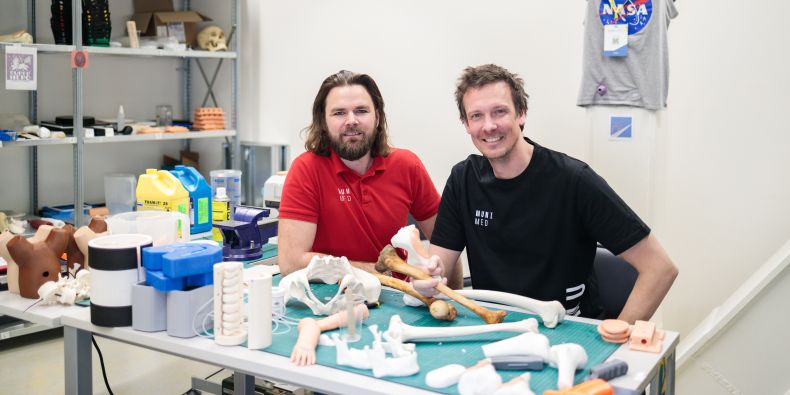A pad with a simulated injury made from materials that resemble the surface and colour of the human. It allows the students of medicine to practice suturing. If bought from a third-party supplier, it would have cost CZK 500. The facility on the fourth floor of the Simulation Centre can produce it at a fraction of this price thanks to Jiří Travěnec and Michal Šemora. The raw material can be recycled and reused.
“Sustainability, self-reliance and cost-effectiveness are key aspects of our project. And the fact that we produce everything on the in-house basis means that we do not have to keep substantial stock,” says Vice-Head for Technologies Jiří Travěnec. Upon the opening the centre, he adds, the team of technicians became aware of the fact that 3D printing of models and simulation medicine are closely related. Back then the team had two 3D printers, now they have six. “We started from the humble beginnings, we would design and produce all kinds of holders and stands that we needed in lecture rooms. And then we moved on to the teaching models using CT imaging and 3D scanning,” technician Michal Šemora says, commenting on the production of models, spare parts and consumables using siliconing and 3D printing. According to him the advantages of silicone include the fact that it is elastic and offers some resistance, which imitates real tissues.
The centre’s technicians have so far produced other items, including those for first aid, internal medicine or neonatology. “The model of a newborn’s stomach with an imitation of the umbilical cord was developed in coordination with paediatricians. The original manufacturer’s model was not suitable for our teaching purposes,” Šemora explains.
The production of devices and models developed in 2022 into a full-scale global database and portal where anatomically correct models will be published for the purpose of 3D printing for courses in morphology. Models created using actual anatomy data are reviewed prior to publication to ensure accuracy.
Nearing launch is a portal with seventy samples allowing for browsing by categories, viewing and downloading of 3D models. “The aim of the project is to offer the general public, especially from the medical and education sectors, a database of models for 3D printing for teaching purposes. Its contents cover the most professional level in terms of defects, traumas or complex fractures, as well as lower levels in terms of anatomical models of organs and bones,” Jiří Travěnec explains, adding that the added value of the project was the opportunity for his team to learn to operate the technology for the production of these models and to obtain funding for the equipment. The result is a top-quality facility whose knowledge can be shared with other professionals involved in the 3D printing of anatomical models.
The Simulation Centre will aim to promote the portal over the upcoming months. “Not only did we improve 3D printing on our internal basis, we also boosted cooperation at the European level. We introduced the project at a conference and workshop last year, and now we want to utilise the European association of information centres to contact a broad range of potential partners,” Travěnec adds.
SIMU’ technicians cooperate with medical professionals at the teaching level and produce models according to their needs. More recently, 3D printing of anatomical models has become useful in cooperation with St. Anne’s University Hospital where it is expected to help individual patients. “This is our first overlap with clinical medicine. Doctors can send us images of a broken bone; we can produce a model and the doctors can then test the placement of titanium pads, or they can model a cast or test the best place for drilling. This will help them determine whether certain condition is operable, or whether to avoid stressing the patient’s organism,” Šemora explains. SIMU can process a request from the hospital within hours or by the following day.
